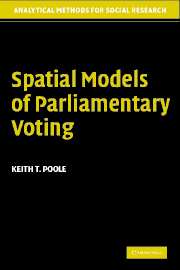Book contents
- Frontmatter
- Contents
- List of Tables and Figures
- Preface
- 1 Introduction
- 2 The Geometry of Parliamentary Roll Call Voting
- 3 The Optimal Classification Method
- 4 Probabilistic Spatial Models of Parliamentary Voting
- 5 Practical Issues in Computing Spatial Models of Parliamentary Voting
- 6 Conducting Natural Experiments with Roll Calls
- 7 Conclusion
- References
- Index
2 - The Geometry of Parliamentary Roll Call Voting
Published online by Cambridge University Press: 24 November 2009
- Frontmatter
- Contents
- List of Tables and Figures
- Preface
- 1 Introduction
- 2 The Geometry of Parliamentary Roll Call Voting
- 3 The Optimal Classification Method
- 4 Probabilistic Spatial Models of Parliamentary Voting
- 5 Practical Issues in Computing Spatial Models of Parliamentary Voting
- 6 Conducting Natural Experiments with Roll Calls
- 7 Conclusion
- References
- Index
Summary
Overview
In this chapter, I show the geometry of parliamentary roll call voting for the simplest possible spatial model; each legislator is represented as a point and each roll call is represented as two points – one corresponding to the policy outcome associated with Yea, and one corresponding to the policy outcome associated with Nay. I do not consider abstention or multichoice spatial models. I assume that legislators vote sincerely – that is, they vote for the outcome closest to their ideal point – and that there are no voting errors. Hereafter, I will refer to this simple two-outcome spatial model with no error as perfect voting.
In Chapter 1, I outlined a simple theory of spatial maps that I call the basic-space theory of ideology. This theory is a parsimonious tool for understanding the construction and interpretation of spatial maps. The maps are based on a simple Euclidean geometry of points, lines, and planes, and the purpose of this chapter is to show the basics of this geometry.
Understanding this geometry is an essential foundation for realistic models of choice that allow for error. Perfect voting is not a “pie in the sky” assumption. For example, a two-dimensional spatial model correctly classifies over 95 percent of the choices in most legislative sessions during the French Fourth Republic (Rosenthal and Voeten, 2004), and a one-dimensional spatial model correctly classifies over 90 percent of the choices in recent U.S. Houses and Senates.
I will analyze the one-dimensional problem first.
- Type
- Chapter
- Information
- Spatial Models of Parliamentary Voting , pp. 18 - 45Publisher: Cambridge University PressPrint publication year: 2005

